
Recently, many traditional as well as modern exercise forms have reinvented themselves and emerged as popular solutions for weight loss. Qigong is a popular instance of just such an exercise form that, despite being an ancient Chinese traditional art, has re-emerged as the modern day recourse to lose weight and shape up flabby loose skin. The exercise form is graceful and implements gradual steps to complete a harmonious routine. The literal meaning of Qigong is energy cultivation and rightly, so, because the exercise form leaves you rejuvenated and re-energized. In the following list, the focus is on specific Qigong routines targeting flabby legs and shaping up loose (inner and outer) thigh muscles. However, it is important to understand that none of these exercises uses isolated movements of legs; rather, the focus is on utilizing breathing techniques and range of movements (arms, lower back, upper back, and neck) to make sure that the flexibility and toning is balanced.
Pressing the heaven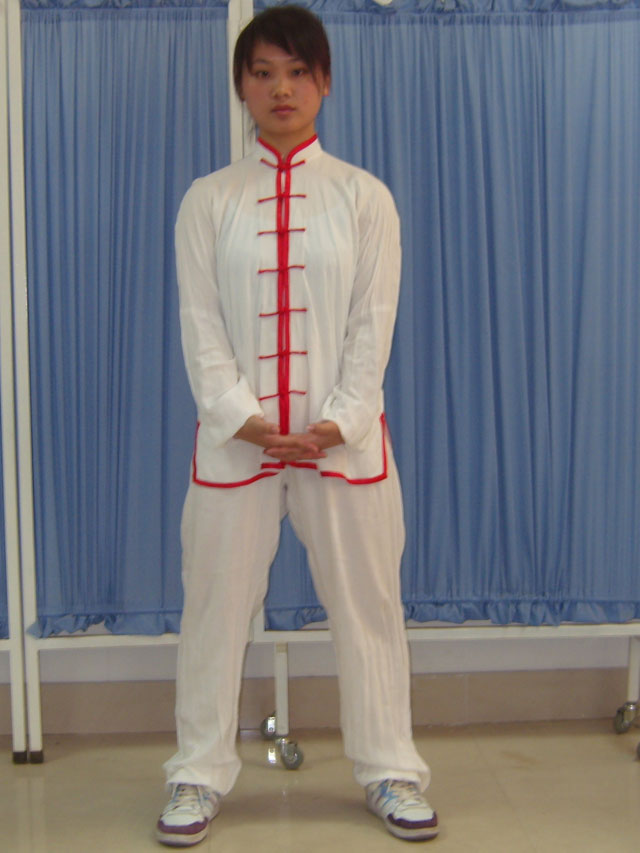
Pressing the heaven is a part of the Qigong eight parts brocade series. The exercise is a martial arts form where the movement imitates pressing on the heavens with both hands. To do the exercise, prepare by stepping out with your left leg (shoulder width), slightly bend the knees, and keep a straight posture with your buttocks directly aligned with your back in a straight line. Gradually raise both hands to waist level, keep the palms apart (2-5 inches, fingers pointing towards the opposite hand). Raise the hands to your forehead level while maintaining the stance. Slowly stretch your whole body up as you stretch your arms up (imitating pushing the heavens). During the upwards stretch, you will tighten your abdominal muscles and relax them as you gently come down. Breathe normally. Repeat for the other leg and you can complete a set of three reps (gradually increase the reps according to your comfort level).
This exercise helps in exercising the legs as well as opening up your chest for clearer (deeper) breathing, which energizes the whole system. You can practice this routine in the mornings or evenings. It will be advisable if you practice the form with a trainer initially before starting on your own. Almost all body types can safely practice this routine.
Roc spreads its wings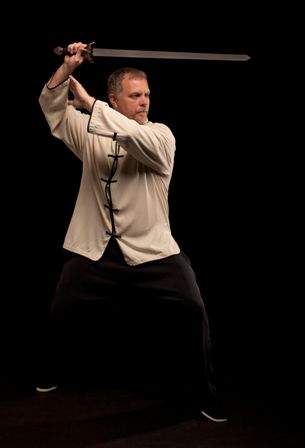
The “Roc spreads its wings” is another vital form of Qigong exercises. The influence of different birds and their body (especially wings) movements has been an inspiration for many martial arts movements.
To do the move, place your feet shoulder width part, direct the heels slightly towards the center for better balance. Now, slightly bend your knees while raising your arms from your shoulders (imitating a giant bird taking flight). Raise your body on your heels. Gradually get back to normal position. Repeat the move for two sets of three reps each. You should follow a trainer to understand the correct posture for the movement. This move can help tone the legs as well as improve posture, back strength, and balance. You should avoid this move if you have weak knees or during pregnancy.
Flowing Qi
For this exercise, you can either use a chair (for people with joint aches and knee problems) or practice without one. Sit on the edge of the chair or bend your knees to simulate sitting on a chair. Keep your feet flat on the ground and while keeping them rooted, imagine your body flowing and relaxed. Raise your arms while inhaling and bring them down while you exhale. Keep the feet rooted at all times and feel the energy flowing through your body.
This exercise will better help you lose weight on your legs if you can advance to practicing without the chair. However, as an added benefit (with or without the chair), it rejuvenates you and balances your stress levels. Practice as per your comfort levels. Make sure to discuss with your trainer or physician before attempting, if you have knee or joint related problems. This exercise can be performed during both morning and evening workout sessions.
Swimming dragon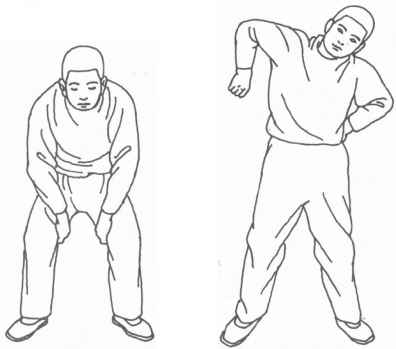
The swimming dragon can be a part of your total Qigong workout routine or it can be used as a complete routine by itself. Stand while keeping your feet together with arms at your side. When you move your arms to your front, put your palms together (while fingers point towards the ground). Now twist your complete body led by your fingers towards various points of the compass. This movement provides total body flexibility. The additional work on the legs (to keep the balance of the body throughout the movement) helps in toning up the leg muscles. The movement also benefits your metabolic as well as immune system, making them stronger. Do not practice the movements without a trainer’s supervision until you master the technique. This technique should be avoided during pregnancy or in case of back injuries. Make sure to warm up before attempting the movement, as it might cause additional aches and pains after the routine. Practice at least two sets or three reps.
Pushing the mountain aside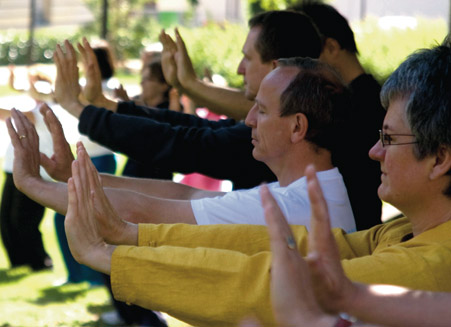
This is another part of the eight forms of the Qigong brocade series. The movement imitates its name to do this movement. Prepare by standing with your legs placed two shoulder widths apart and while keeping a straight upper body posture, squat down. Put your hands on your hips and turn your body (from the waist) to the left. Your elbow should be pointed towards the north direction. Hold the position for as long as you can comfortably and then gradually return to the original position. Repeat this 7 to 8 times for each side. This posture helps in losing flabby weight from around your legs, waist, and hip regions. Do not practice without a professional trainer (especially if you are a beginner, injured around the hip or lower back area).
Bouncing on toes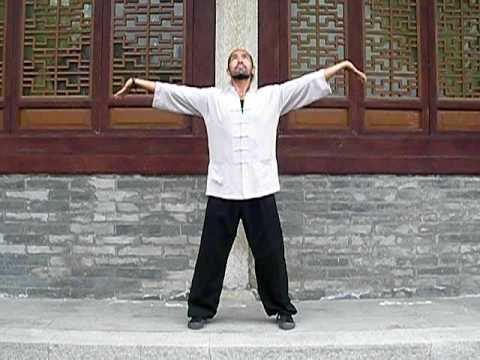
The bouncing motion of this exercise form will help you strengthen your lower belly, calf, and leg muscles. In addition, you will improve your posture and body balance. Start by relaxing your body and standing erect with legs placed comfortably apart. Now, move the right foot forwards (about one foot distance from the left foot). Keep your weight balanced on the left foot but keep the right foot on your toes (do not put heel on the floor). Bend the left knee to maintain the balance and prevent injury. Now holding the position gradually bends both knees (not the body from the waist). Keep the arms next to the hips, palms facing down. With every bend, push your palms down as if pushing the energy downwards. Make sure to have a trained supervisor helping you initially to get the movement right. Do not practice if you have knee or joint related injuries.
Toe bend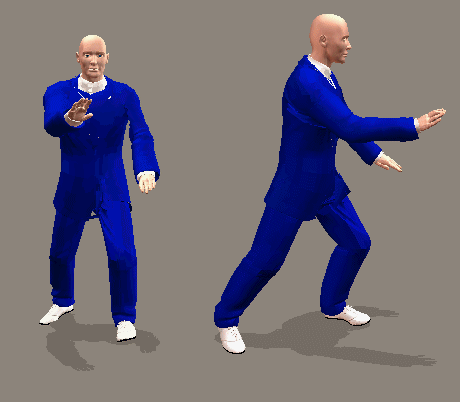
This is a simple Qigong movement that can greatly enhance the flexibility, mobility and over all toning of your body. To do the movement, place your feet shoulder width apart and stand tall. Keep the knees bent (slightly) to avoid injury. Now place both hands on the hips and gradually follow your hands as you bend down to your toes, while bending your knees. Exhale at this point and hold the position for a few counts. Again, inhale as you return to the initial position. Repeat the exercise for at least 7 to 8 counts. A trainer should guide you through the process (especially if you have any knee or back related injuries, or if you are a beginner in Qigong).
Archer
This Qigong movement is very popular due to its overall benefits in aligning bad postures, helping with backaches, and toning up the lower body as well as the arms. To do the movement, stand straight keeping the legs at least two shoulder widths apart from each other. Place the hands palms inwards on the lower stomach area. Inhale (deep breaths) as you raise the arms up to your chest region. Now rotate your waist in a clockwise direction and pull the arms extending on the left side. Pull the right arm back (as if pulling on a bowstring). Take deep breaths as you repeat the movement at least eight times on each side.
Holding sun in one hand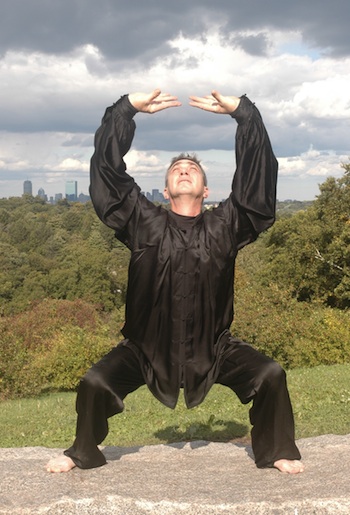
This popular Qigong movement goes through a variety of motions to increase agility and toned condition for your body (including your leg muscles). To practice the movement, stand tall, keeping the feet shoulder width apart. Now, as you exhale, extend both arms up to your waist, bring left palm to left side, and take a short step forward on your right leg. Inhale and repeat the movement in the opposite direction. Again, exhale and transfer your weight to the opposite leg, draw the right hand to your body in a clockwise arc, gradually (as if you are holding the sun in this hand). Repeat in the other direction. Always raise your forward foot on your toes while transferring body weight to the other leg. Start with a trainer to get the motion and the posture right.
Scooping the sea and looking at horizon
The bending and stretching form of this movement imitates as if scooping the sea, hence the name. This is a traditional Qigong movement, which helps improve the shape of your lower body, your balance, and your digestive system. The movements are beneficial for the spine too.
Stand with feet relaxed, knees bent, and a shoulder width distance between the feet. Now putting weight on right foot, take a small step forward with your left foot. Inhale and extend arms downwards, bending, and completing a scooping arc with your right hand (while crossing right hand over left hand over your left knee). This is scooping the sea motion. Stretch up straight and extend arms upwards completing the arc. This is looking to the horizon motion. Return to normal position and repeat for the other side.
A trainer should guide you through the process and help you time your movements for maximum results. Avoid the movement during pregnancy and keep it mild during lower back injuries.
Punching angrily
This is a great stress reliever as well as helps in increasing body balance and flexibility. Take a Squatting position (half chair position) while keeping the feet almost two-shoulder widths apart. Now take your right arm and punch (use a fierce motion to relieve maximum stress) across your body (pointing towards left side). Repeat the motion with the opposite hand towards the opposite direction. Practice at least three sets of three reps each. Always breathe out during the punch and breathe in while preparing to punch on the other side. A trainer should guide initially. Do not practice during pregnancy.


